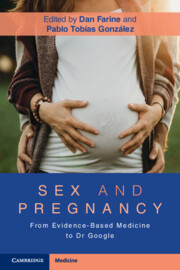Book contents
- Sex and Pregnancy
- Sex and Pregnancy
- Copyright page
- Dedication
- Contents
- Contributors
- Preface
- Section 1 General Issues
- Section 2 Specific Issues
- Chapter 9 Sex and Assisted Reproductive Technologies
- Chapter 10 The Male Partner’s Perspective
- Chapter 11 Sex in the First Trimester
- Chapter 12 Sex in the Second and Third Trimesters
- Chapter 13 Sex with Bleeding in the First Trimester
- Chapter 14 Sex with Bleeding in the Second and Third Trimesters
- Chapter 15 Short Cervix and Sex
- Chapter 16 Preterm Birth and Sex
- Chapter 17 Multiple Pregnancies and Sex
- Chapter 18 Special Pregnancies and Sex
- Chapter 19 Air Embolism Related to Sex in Pregnancy and the Postpartum
- Chapter 20 Pelvic and Ovarian Masses during Pregnancy
- Chapter 21 Sexually Transmitted Infections and Pregnancy
- Chapter 22 Sex for Induction of Labor
- Chapter 23 Nipple Stimulation during Pregnancy
- Chapter 24 Sex during the Postpartum
- Chapter 25 Sex after Pelvic Floor Injuries
- Chapter 26 Miscarriages, Spontaneous Abortions, Stillbirths, and Sex
- Index
- References
Chapter 12 - Sex in the Second and Third Trimesters
from Section 2 - Specific Issues
Published online by Cambridge University Press: 09 November 2022
- Sex and Pregnancy
- Sex and Pregnancy
- Copyright page
- Dedication
- Contents
- Contributors
- Preface
- Section 1 General Issues
- Section 2 Specific Issues
- Chapter 9 Sex and Assisted Reproductive Technologies
- Chapter 10 The Male Partner’s Perspective
- Chapter 11 Sex in the First Trimester
- Chapter 12 Sex in the Second and Third Trimesters
- Chapter 13 Sex with Bleeding in the First Trimester
- Chapter 14 Sex with Bleeding in the Second and Third Trimesters
- Chapter 15 Short Cervix and Sex
- Chapter 16 Preterm Birth and Sex
- Chapter 17 Multiple Pregnancies and Sex
- Chapter 18 Special Pregnancies and Sex
- Chapter 19 Air Embolism Related to Sex in Pregnancy and the Postpartum
- Chapter 20 Pelvic and Ovarian Masses during Pregnancy
- Chapter 21 Sexually Transmitted Infections and Pregnancy
- Chapter 22 Sex for Induction of Labor
- Chapter 23 Nipple Stimulation during Pregnancy
- Chapter 24 Sex during the Postpartum
- Chapter 25 Sex after Pelvic Floor Injuries
- Chapter 26 Miscarriages, Spontaneous Abortions, Stillbirths, and Sex
- Index
- References
Summary
Intercourse is an integral part of human well-being and over the course of a pregnancy its frequency usually declines, at times due to discomfort and prejudice but in some cases due to medical advice. This chapter reviews the evidence for the safety of sexual activity in low- and high-risk pregnancies and establishes the validity of recommendations of abstinence in different clinical scenarios. The main concern regarding sexual intercourse is its ability to cause uterine contractions that could possibly result in premature labor or endanger a pregnancy complicated by placental pathologies. In light of the existing evidence, which is limited in amount and quality, it seems that coitus does not produce contractions powerful enough to precipitate labor, either in women who are at increased risk for preterm labor or in those who are not. Another significant concern is the possibility that sexual intercourse may trigger migration of pathogens to the cervix and cause an ascending infection and chorioamnionitis, especially in the setting of premature rupture of the membranes, and some studies indeed support this hypothesis; however, they were conducted decades ago, and their quality is low. It is clear that there is insufficient high-quality research to establish proper evidence-based guidelines for women who wish to receive medical advisement regarding sexual activity. However, when examining the existing literature and taking into consideration that coitus is part of every couple’s healthy and normal lifestyle, it seems that overall engaging in sexual activity during pregnancy is safe. In selected cases of high-risk pregnancies, recommendations should be tailored individually according to the parturient’s obstetric history.
- Type
- Chapter
- Information
- Sex and PregnancyFrom Evidence-Based Medicine to Dr Google, pp. 77 - 91Publisher: Cambridge University PressPrint publication year: 2022

